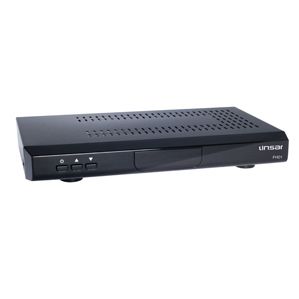As we approach kick-off in Johannesburg, the market for Freeview HD set-top boxes is getting fierce. Prices are being slashed for boxes that offer both HD pictures and some nifty extras - can this back-to-basics box from British brand Linsar survive?
Our quick take
Pin-sharp high-def TV and excellent upscaling make this small set-top box one to savour, though its old fashioned user interface, lack of Common Interface slot (for Top-Up TV) and otherwise basic feature count make it of questionable value when compared to busier boxes on sale.

Linsar FHD1 receiver - 3.0 / 5
| FOR | AGAINST |
|---|---|
|
|
The answer is in this digital box’s simplicity. For there is no wireless media streaming, no DivX or DivX HD playback, and no BBC iPlayer widget available on the FHD1; you will find these features on similar boxes from Humax, Icecrypt and i-Can that generally cost £10 more (at least at RRP - look online for lowest prices).
Is the FHD1 the patriotic choice? Manufactured by Linsar and sold in John Lewis as that store’s cheapest Freeview HD box, the FHD1 does have a few tricks up it sleeve. Its chief future-proof feature is its rear panel’s Ethernet LAN port, which will come into its own given time. Once Freeview makes broadband-delivered on-demand fare such as ITV Player and BBC iPlayer part of the interactive service - something that should happen late this year or early next - the FHD1 will only require a software upgrade to be fully compliant.
On the other hand, the FHD1 does not include a Common Interface port, making it impossible to add viewing cards for subscription TV add-on channels - such as the Top-Up TV package that could soon contain Sky Sports channels.
The FHD1 is set-up well to serve a HD Ready TV though; an HDMI output makes sure of that, though the appearance of a Scart socket doesn’t seem necessary. An RF aerial and loopthrough slot mark the end of its picture ports, with sound being offered either as a bitstream or PCM feed over HDMI, or to a home cinema amp through a digital optical audio output.
The FHD1’s remote control represents a good stab at adding some style, though its long arched design proves tricky to operate while holding with one hand. The graphical user interface it controls is equally flawed; its lilac and red menus look one-dimensional, soft and a tad old fashioned, especially when compared to similar efforts from the likes of the Humax HD-Fox T2, Icecrypt’s T2200, i-Can’s Easy HD or Philips DTR5520.
Those onscreen menus - including its 7-day electronic programme guide - did jam a few times during our test and aren’t always responsive enough, though when they’re behaving it’s a cinch to operate the FHD1.
So far, so mediocre, but this black box takes a huge leap forward when we tune in its high-def TV channels. The BBC HD channel’s rolling daytime show reel shows-up some fabulous images, none of which are blighted by any kind of picture noise. Solid, clean and with realism a-plenty, the FHD1’s high-def performance carries on with SD channels. Almost all Freeview HD set-top boxes claim to upscale SD to 1080p HD quality, though don't all manage it successfully. The FHD1 isn’t in that camp; in our test ITV is bolstered to a level that makes it watchable on a bigscreen TV - surely the destiny of Linsar’s FHD1.
To recap
Pin-sharp high-def TV and excellent upscaling make this small set-top box one to savour, though its old fashioned user interface, lack of Common Interface slot (for Top-Up TV) and otherwise basic feature count make it of questionable value when compared to busier boxes on sale
